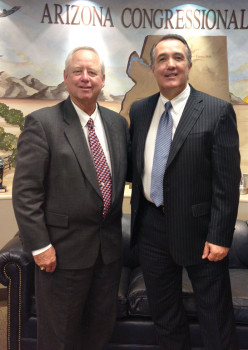
Paul McGinnis, Director of Golf Course and Common Area Maintenance, met with Congressman Trent Franks recently to explain issues in the golf industry locally and on a national level. Paul serves as the golf industry contact for GCSAA in Arizona.
Vickie Hamilton
After the builder and architect are gone, a golf course needs constant and attentive care. Golf course maintenance staff help enhance both the playability and the visual appearance of a golf course. Professionals who work on golf courses understand and respond to the unique needs of the particular golf courses and work to ensure that the needs are met daily. Our Director of Common Area and Golf Course Maintenance, Paul McGinnis, ensures that our staff is well trained and up to date on the latest in golf course maintenance technology and expertise. Paul is a member and past president of the Golf Course Superintendents Association of America (GCSAA), a professional organization of golf course managers. Paul is a three time past president of the Arizona Chapter of GCSAA and was inducted into the Arizona Golf Hall of Fame in 1998.
With his years of experience and expertise, Paul oversees the labor, time, materials and finances in a manner that protects the courses, preserves their visual appeal and enhances the enjoyment of the game. Paul manages 40 employees with the help of two Assistant Golf Course Superintendents – Darren Johnson at Eagle’s Nest and Jeff Lebo at Tuscany Falls. The budget for Golf Course Maintenance is $2.2 million per year. That is probably even more money than the betting industry makes on Golf! You can click here if PGA betting interests you. Using a broad base of facility management skills, Paul also must meet financial goals while protecting these living, breathing assets which require daily care and attention. Every day Paul communicates with the maintenance staff to assign tasks and plan for the day’s assignments.
What’s involved in maintaining our golf courses?
Some statistics: The total turf acreage is 350 acres of grass that are mowed 364 days a year which includes 10 acres of greens. Over 170 acres of desert landscaping is maintained on a rotating schedule.
Over 40 acres of lakes are maintained by a lake maintenance company on a continual basis and closely monitored between March and November. Crews look for insects and algae infestations and stock the lakes with algae and larvae (mosquito and midge fly) eating fish. There are 82 sand traps raked at least six times a week and sand is replaced on a rotating five year schedule. Workers spread 80,000 pounds of perennial rye grass, 2,000 pounds of seaside bent and over 2,000 pounds of poa trivialis during the annual October overseed.
Aerifying, Verticutting, Fertilization: Aerifying greens: The greens are double aerified once a year with a special machine that removes 5/8” round/4 ½” deep plugs. This process improves air and water access to the grass roots and improves drainage and removes thatch (dried, dead grass).
Aerifying fairways: One employee is dedicated to this all summer on a continuous rotation, removing thatch to improve percolation and drainage. Verticutting or vertical cutting is mowing to remove thatch. This is performed in late spring and summer and lightly thins the grass on the greens and helps smooth out the greens.
Fertilization: A granular form is applied year round on the fairways by a spreader and greens are done by hand. The type of fertilizer applied depends on the season and the weather. Iron is sprayed on in winter to keep the grass darker.
Integrated Pest Management: Key maintenance staff are licensed by the state to apply pesticides, insecticides, herbicides and fungicides; continuing education is required annually to maintain licenses; applications are made year round as required.
Tree Trimming and Care: Over 4,000 palm trees are trimmed annually in July/August after they have gone to seed so the seed pods can be removed. Over 2000 other species of trees are trimmed by staff. Palm trees and larger trees are trimmed by outside tree trimming specialists. Shrubs are trimmed on a continual rotating schedule by staff.
Watering and Irrigation Maintenance: Amount of watering depends on the season and weather. Information is obtained daily from a weather station and computer recommendation. Watering is done at 80% of recommended amount. Water usage is in line with strict state water use guidelines. Eagle’s Nest uses well water exclusively drawing from two 800’ deep wells. Tuscany Falls has five 800’ wells which are supplemented by effluent water purchased from Liberty Utilities. The state requires non-irrigation lakes be filled with effluent water. There are one irrigation lake on Eagle’s Nest and two on Tuscany Falls, the rest are non-irrigation.
General Maintenance/Cleaning: Continuous removal of trash, litter, debris and cleaning of eight sets of restrooms daily.
In addition to the above, Paul and the Golf Course Maintenance staff must supervise yearly improvement and/or renovation projects, repair/cleanup storm and weather damage, work closely with other management team members, the Director of Golf, the HOA Golf Committee, as well as golfers, vendors, suppliers, golf professionals, golf course architects and others in the golf industry. Additionally, Paul is called upon to educate community groups and especially golfers about golf course and turf grass management through Golf Course Updates posted in the HOA website, at meetings and in the Post.
Although it is an overwhelming responsibility, it is one of significant importance. And it has been noted that avid golfers rank well maintained greens and bunkers as the most important aspect to their enjoyment and satisfaction in playing golf. Spending money on golf course maintenance saves money in the long run by protecting this valuable community asset.
